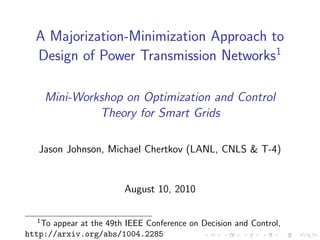
Network Optimization Brief
- 1. A Majorization-Minimization Approach to Design of Power Transmission Networks1 Mini-Workshop on Optimization and Control Theory for Smart Grids Jason Johnson, Michael Chertkov (LANL, CNLS & T-4) August 10, 2010 1 To appear at the 49th IEEE Conference on Decision and Control, http://arxiv.org/abs/1004.2285
- 2. Introduction Objective design the network, both the graph structure and the line sizes, to achieve best trade-off between efficiency (low power loss) and construction costs. Our approach was inspired by work of Ghosh, Boyd and Saberi, Minimizing effective resistance of a graph, ’09. Overview resistive network model (DC approximation) convex network optimization (line sizing) non-convex optimization for sparse network design robust network design
- 3. Resistive Network Model Basic current flow problem (power flow in AC grid): ui graph G θij injected currents bi sources bi > 0 sinks bi < 0 junction points bi = 0 line conductances θij ≥ 0 Network conductance matrix: k=i θik , i = j Ki,j (θ) = −θij , {i, j} ∈ G Solve K (θ)u = b for node potentials ui . Line currents given by bi→j = θij (uj − ui ).
- 4. Resistive Power Loss For connected G and θ > 0, ˆ u = K −1 b (K + 11T )−1 b. Power loss due to resistive heating of the lines: L(θ) = ˆ θij (ui − uj )2 = u T K (θ)u = b T K (θ)−1 b ij For random b, we obtain the expected power loss: ˆ ˆ L(θ) = b T K (θ)−1 b = tr(K (θ)−1 · bb T ) ˆ tr(K (θ)−1 B) Importantly, this power loss is a convex function of θ.
- 5. Convex Network Optimization We may size the lines (conductances) to minimize power loss subject to linear budget on available conductance: minimize L(θ) subject to θ≥0 T α θ≤C α is cost of conductance on line . Alternatively, one may find the most cost-effective network: minθ≥0 {L(θ) + λαT θ} where λ−1 represents the cost of power loss (accrued over lifetime of network).
- 6. Four Examples – Optimal Network Design
- 7. Imposing Sparsity (Non-convex continuation) We now add a zero-conductance cost on lines: min{L(θ) + αT θ + β T φ(θ)} θ≥0 where φ(t) is (element-wise) unit step function. We smooth this combinatorial problem to a continuous one, replacing the discrete step φ by a smooth one: 1 t φγ (t) = t +γ 0 t 0 1 The convex optimization is recovered as γ → ∞ and the combinatorial one as γ → 0.
- 8. Majorization-Minimization Algorithm Approach inspired by Candes and Boyd, Enhancing sparsity by reweighted L1 optimization, 2009. Uses majorization-minimization heuristic for non-convex optimization. Iteratively linearize φγ about previous solution: θ(t+1) = arg min{L(θ) + [α + β ◦ φγ (θ(t) )]T θ} θ≥0 results in a sequence of convex network optimization problems with reweighted α. Monotonically decreases the objective and (almost always) converges to a local minimum.
- 9. Four Examples – Sparse Network Design
- 10. Adding Robustness To obtain solutions that are robust of failure of k lines, we replace L(θ) by the worst-case power dissipation after removing k lines: Lk (θ) = max L((1 − z) ◦ θ) z∈{0,1}m |1T z=k This is still a convex function. It is tractable to compute only for small values of k. Method can be extended to also treat failures of generators. Solved using essentially the same methods as before...
- 11. Four Examples – Robust Network Design
- 12. Conclusion A promising heuristic approach to design of power transmission networks. However, cannot guarantee global optimality. Future Work: Bounding optimality gap? Use non-convex continuation approach to place generators possibly useful for graph partitioning problems adding further constraints (e.g. don’t overload lines) better approximations to AC power flow? Thanks!